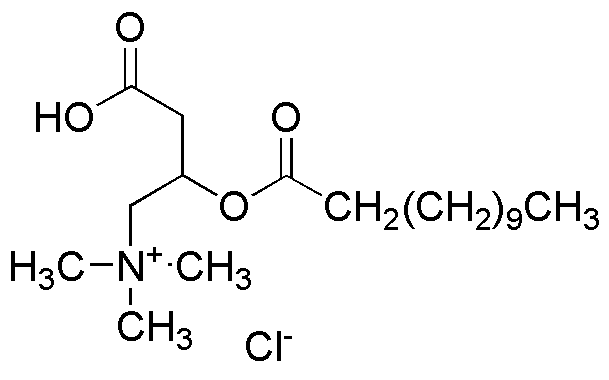|
DL-Lauroylcarnitine chloride is widely utilized in research focused on:
- Pharmaceutical Development: This compound is used in the formulation of drug delivery systems, enhancing the bioavailability of poorly soluble drugs, which is crucial for effective treatment.
- Cosmetic Industry: It serves as an emulsifier and skin-conditioning agent in creams and lotions, improving texture and moisture retention, making products more appealing to consumers.
- Nutrition Supplements: Commonly found in dietary supplements, it aids in fat metabolism and energy production, appealing to athletes and health-conscious individuals.
- Research on Metabolic Disorders: It is employed in studies investigating metabolic pathways, particularly in conditions like obesity and diabetes, providing insights that can lead to new therapeutic strategies.
- Animal Feed Additives: Used to improve the nutritional profile of animal feeds, it enhances growth performance and overall health in livestock, benefiting the agricultural sector.
General Information
Properties
Safety and Regulations
Applications
DL-Lauroylcarnitine chloride is widely utilized in research focused on:
- Pharmaceutical Development: This compound is used in the formulation of drug delivery systems, enhancing the bioavailability of poorly soluble drugs, which is crucial for effective treatment.
- Cosmetic Industry: It serves as an emulsifier and skin-conditioning agent in creams and lotions, improving texture and moisture retention, making products more appealing to consumers.
- Nutrition Supplements: Commonly found in dietary supplements, it aids in fat metabolism and energy production, appealing to athletes and health-conscious individuals.
- Research on Metabolic Disorders: It is employed in studies investigating metabolic pathways, particularly in conditions like obesity and diabetes, providing insights that can lead to new therapeutic strategies.
- Animal Feed Additives: Used to improve the nutritional profile of animal feeds, it enhances growth performance and overall health in livestock, benefiting the agricultural sector.
Documents
Safety Data Sheets (SDS)
The SDS provides comprehensive safety information on handling, storage, and disposal of the product.
Product Specification (PS)
The PS provides a comprehensive breakdown of the product’s properties, including chemical composition, physical state, purity, and storage requirements. It also details acceptable quality ranges and the product's intended applications.
Certificates of Analysis (COA)
Search for Certificates of Analysis (COA) by entering the products Lot Number. Lot and Batch Numbers can be found on a product’s label following the words ‘Lot’ or ‘Batch’.
*Catalog Number
*Lot Number
Certificates Of Origin (COO)
This COO confirms the country where the product was manufactured, and also details the materials and components used in it and whether it is derived from natural, synthetic, or other specific sources. This certificate may be required for customs, trade, and regulatory compliance.
*Catalog Number
*Lot Number
Safety Data Sheets (SDS)
The SDS provides comprehensive safety information on handling, storage, and disposal of the product.
DownloadProduct Specification (PS)
The PS provides a comprehensive breakdown of the product’s properties, including chemical composition, physical state, purity, and storage requirements. It also details acceptable quality ranges and the product's intended applications.
DownloadCertificates of Analysis (COA)
Search for Certificates of Analysis (COA) by entering the products Lot Number. Lot and Batch Numbers can be found on a product’s label following the words ‘Lot’ or ‘Batch’.
*Catalog Number
*Lot Number
Certificates Of Origin (COO)
This COO confirms the country where the product was manufactured, and also details the materials and components used in it and whether it is derived from natural, synthetic, or other specific sources. This certificate may be required for customs, trade, and regulatory compliance.


